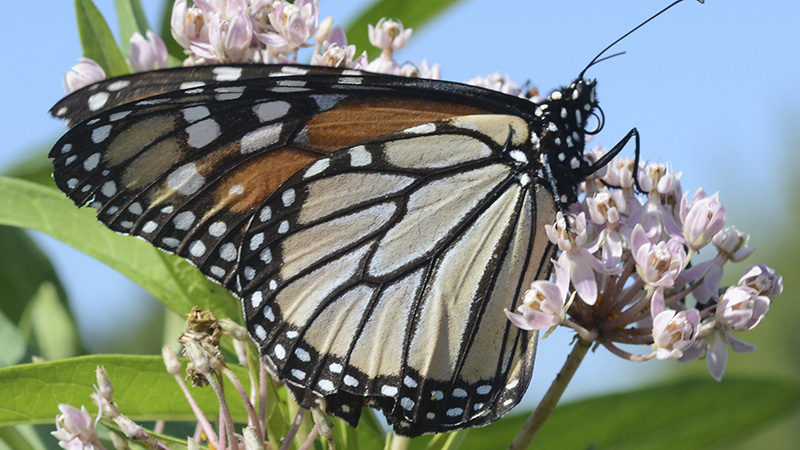The monarchs are here! Where’s their milkweed?
Published 7:00 am Wednesday, April 17, 2019

- Photo of a female monarch in Poplarville. Photo by Amy Nichols
By Patricia R. Drackett, Director and Assistant Extension Professor of Landscape Architecture
The Crosby Arboretum, Mississippi State University Extension Service
The last two weeks the Arboretum has been receiving signals that are loud and clear – it’s a very a good year for monarch butterflies here on the Mississippi Gulf Coast. We’ve been getting calls from people reporting that their milkweed plants are crawling with the green, yellow, and white striped monarch caterpillars.
In the Arboretum’s Pollinator Garden, we have planted dozens of swamp milkweed (Asclepias incarnata), and to our delight just a few days ago, we found tiny caterpillars nestled in the leaves. A few were not so tiny! We found several fat caterpillars gnawing on bare stems, which was all that remained of their meal.
Monarch butterflies began to be reported in Louisiana and Mississippi in early March, as they began their northward migration from overwintering sites in Mexico. Now, gardeners are finding eggs on their milkweed leaves, and caterpillars of all sizes.
You can report your own sightings of monarch butterflies and view maps that track the insects on the Journey North website (www.journeynorth.org<http://w
In response to the many inquiries we received at the Crosby Arboretum following the low 2013-14 population numbers, we embarked on research into native milkweed species that will grow in Mississippi. Trials have shown that the best milkweed for the home garden is indeed swamp milkweed.
Swamp milkweed, however, is only just now beginning to be available. Changes certainly don’t happen overnight! We’ve been selling this species at our plant sales, and have noticed other botanical gardens and specialty garden centers carrying it. This spring, we will have the seed in our gift shop. Area gardeners reported excellent results last year with growing this perennial plant from seed.
The most common species found in area garden centers is a milkweed that is beautiful, easy to grow, but in unfortunately is invasive and highly toxic. This plant is a tropical milkweed, Asclepias curassavica. All milkweed is toxic, and it is these substances, called cardiac glycosides, that are ingested at no harm to the caterpillar, causing them to taste unpleasant to predators. If tropical milkweed sap is wiped into the eyes, it can cause pain and swelling that will persist for days. There is much information on the Internet on the reasons not to plant the tropical species, if you would like to research this further.
The resources menu on the Monarch Joint Venture website (www.monarchjointventure.org<h
What can you do to prepare for hosting monarchs? Provide their host plants! But, you must already have sufficient numbers of milkweed in your garden in the spring when they are passing through our area on their journey north. You also need to provide them with food in the form of nectar-rich flowering plants.
Growing milkweed from seed is a very inexpensive way to grow large quantities of this plant. If one caterpillar needs to consume as much as two to three plants to mature through all five growth stages, called instars, that’s a heck of a lot of milkweed! It’s best to focus on establish large “mother beds” of milkweed rather planting just a few here or there. Otherwise, you may end up calling your neighbors for help when the monarch caterpillars have eaten all your milkweed!
The March program on Monarchs, Milkweed and Nectar Plants for the Gulf Coast by Pearl River County Master Gardener Amy Nichols will be repeated on Saturday, May 25 from 10:00 to 11:00 a.m. Amy will discuss the life cycle of Monarch butterflies, their migration, the native milkweeds supporting their larval (caterpillar) stage, and the importance of including nectar plants in your Gulf Coast garden to support adult butterflies at critical periods in their life cycle. Members $3, non-members $5.
Reservations are requested for programs. To sign up call 601-799-2311. The Crosby Arboretum is located at 370 Ridge Road in Picayune, at I-59 Exit 4, and open Wednesday through Sunday from 9:00 to 4:00. Leashed pets are welcome.





